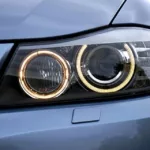There is a surprising number of options out there when it comes to finding the best mountain bike light, but maybe this shouldn’t be a surprise considering how many cyclists absolutely love riding in the pre-morning dawn or long into dusk to get those last few miles in or hit that special place where the sky is exploding with stars. There are even different types of lights out there, and lights that have different reasons. Some are to be seen by others and potential traffic while others are there to give you a more clear view cutting through the darkness.
Understanding Basic Terms
There are certain basic terms that are going to be used no matter what type of mountain bike lights you’re looking at. Fully understanding these terms instead of having a “general hazy idea” of what they mean will help you to make more intelligent decisions when it comes to making that purchase.
Lumens – This is a big one. Every single bike light is measured in lumens and that gives a standard by which they can all be measured. A lumen is an amount of light that is given or emitted. In other words, the more lumens a mountain bike light has, the more total light that particular model gives out.
Lux – Less well known, this is still a really important term to understand. This measures the intensity of light. This gives an idea of just how clear your vision will be in darkness out at 20 feet or thirty feet. This helps a biker learn if a light is really narrow and focused to create a longer distance to see with less side view while a wider light will give a better wide field of view close by but you won’t see as clearly that far ahead.
The combination of lumens and lux will tell you a lot about the overall vision and look this light will give you. While it can be really tempting to go for the light that gives off the most power, this isn’t always going to be the best choice. You need to check battery life, understand how bright is dangerously bright for cyclists from another direction, and more.
This brings us to the next section…
What To Look For In Good Mountain Bike Lights
While it would be a lot easier if there was a one size fits all solution for mountain bikers, such a thing doesn’t exist. What is perfect for Cyclist A might not do the job for Cyclist B and vice-versa. After all, there are hundreds of different mountain bikes out there and that means there must be a variety of lights to match all those options.
Helmet Vs. Handlebar
This is going to be one of the first things to figure out. Are the lights that work for what you specifically need going to be for your helmet or for the handlebars of your bike? There are bikers who prefer both, but there are also specific times when one or the other is clearly going to be the answer.
The pros of helmet lights are obvious. They give light directly to wherever you are looking at the moment. However they also have the drawbacks of flattening out trail features at night which makes it harder to get an accurate read on the trail, and if the helmet light gets knocked off…that can be a scary/dangerous moment for sure.
On the other side, handlebar lights make it easy to operate switches on your mountain bike or clearly see the trail and any switches up ahead.
How Is The Fit?
There’s little point to having the “perfect” bright light for your mountain bike if it doesn’t fit right. An ill fitting bracket that causes a light to shake, wobble, or even come loose is going to be a serious problem. This is a major safety issue in addition to the fact that if the light doesn’t stay perfectly mounted then you won’t get the maximum performance out of it.
Power & Beam Type
This is an important combination depending on what you view as your specific needs. Different beam types create different looks at night, and also change how the power is diffused. Are you looking for more long distance view on a narrow beam or do you need to be aware of as much around you as possible and are willing to give up long distance clarity for that?
There are multiple options when it comes to power and beam types and finding the right combination is going to make all the difference for you between those that are good versus poor fits.
Will The Battery Meet Your Needs?
You don’t want to rely on your emergency power to make sure you can see at night. Some batteries have a very limited amount of emergency time and some are definitely built more for the short term rather than long term. On the other hand there are batteries that can last forever with a low to medium power light but will burn through with a high power light.
In addition to this, make sure you know how your battery performs in cold weather. That makes a huge difference and you want the best battery to connect with your ideal mountain bike light.
Mounting Options
Finally, you want to make sure you can properly attach your mountain bike lights in a way that make them as effective as possible. The best light option is not only going to provide plenty of light, not only have a great battery attached, but also get properly mounted. When all three of these meet together then you’ve found the perfect combination.
As you can see there are plenty of options when it comes to mountain bike lights. Understanding what you’re looking for, the various parts that go with mountain bike lights, and how to bring it all together will help you find what you’re looking for. There’s no reason you can’t enjoy mountain biking at night as long as you get that perfect setup!








